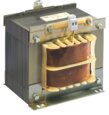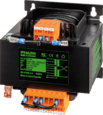How to Choose a Transformer: Transformer Calculator And Sizing
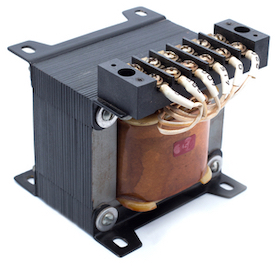
Figure 1: Transformer
A transformer is a passive electrical device that uses electromagnetic induction to transfer electrical energy from one circuit to another. Selecting the proper transformer for an application requires careful consideration of several factors, such as voltage, current, type of load, efficiency, environment, and cost. This article gives a step-by-step guide on choosing a transformer and analyzing various powers in a transformer.
Table of contents
- Selecting a transformer
- Transformer's rated load calculator
- Transformer load capacity
- Transformer efficiency calculation
- Transformer wattage calculator
- Transformer losses
- How to reduce transformer losses
- FAQs
View our online selection of transformers!
Selecting a transformer
Read our overview article on transformers for more information on how they work, their construction, and their types. Transformers are available in multiple designs, specifications, and sizes. It is important to consider the following:
- Step up or down: Choose a step-up or step-down transformer depending on the specific application requirements. For instance, while working on a rectifier, to reduce the supply voltage from 230 to 12 volts, choose a 230-12 volt step-down transformer.
Note: The voltage and frequency of the main power supply vary from one country to the other. Countries like the USA use the main power supply of 120 volts operating at 60 Hz, whereas those in Europe like the UK, Netherlands, and Germany operate at 230 volts and 50 Hz. Choose the transformer accordingly. See the complete list of countries with their corresponding mains power supply voltage and operating frequencies for more details.
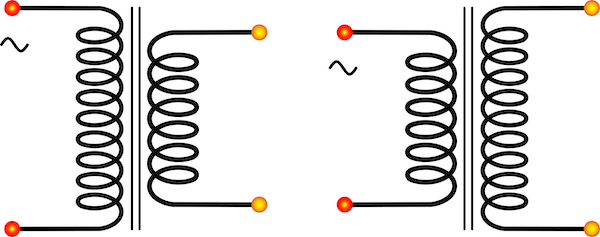
Figure 2: Step-down (left) and step-up (right)
-
Voltage and current specifications: The next step in transformer selection involves determining the load's current and voltage requirements.
- If a building has an AC power supply of 240V and requires 120V for electrical equipment, choose a 240-120V transformer.
Note: Generally, the primary and secondary voltages are listed in the transformer specifications. But in exceptional cases like a current transformer, the primary and secondary currents are listed instead.
- VA: Determine the power required by the load (VA) when selecting a transformer, as transformers are usually specified by their primary and secondary voltages and VA values. Determining these values in advance is necessary to select the proper transformer for the specific application.
Transformer's rated load calculator
The rated load (apparent power) of a transformer is measured by VA (Volt-Ampere). The rated power represents the total amount of power the transformer can deliver to the load. To calculate the rated load needed:
- Determine the current and voltage requirements of the load.
- Multiply the load current in amps (I) and voltage (V) values to get the VA (or rated load) of the transformer.
- For a single-phase transformer,
- For a three-phase transformer,
Note: Small transformers rate their deliverable power in volt-amperes, but much larger power transformers are rated in units of Kilo volt-amperes (kVA), and Mega volt-amperes (MVA). Therefore, VA, kVA, and MVA are similar units. For example, 6 VA is equal to 0.006 kVA.
Read our articles on single-phase and three-phase transformers for more information on their working and design.
Transformer load capacity
Transformer load capacity is the maximum amount of electrical power that a transformer can safely and efficiently handle without overheating or causing damage. For example, a transformer with a 200 VA rating can handle 200 volts at one ampere of current or 100 volts at two amperes of current.
Knowing the VA value of the transformer, it is possible to determine the current across the load by rearranging the equation for VA.
- Obtain the VA rating of the transformer.
- Determine the load’s voltage required.
- Rearrange the equation for VA to solve for current. For example, for a single-phase transformer.
Note: Loading a transformer above 80% of its VA rating is not recommended. After calculating the VA, divide the value by 0.8 to get the minimum VA rating needed. An electrician or electrical engineer should review and confirm all values for safety reasons.
Example
Calculate the rated power of a single-phase transformer with a load voltage of 24 volts and a maximum load phase current of 5 amperes.
The VA rating of the transformer = (V × I)= (24 × 5) = 120 VA
Dividing the VA by 0.8, the revised VA = 150
Choose a transformer with a VA rating of approximately 150 for the load.
Transformer efficiency calculation
The efficiency of a transformer is given by:
When dealing with transformers, the primary power is generally referred to as volt-amps (VA) to distinguish it from the secondary power. Therefore, the efficiency is given by:
Transformers have high efficiencies due to the absence of moving parts. Transformers are also called static AC machines. The efficiency of a well-designed power transformer is very high, averaging over 98 percent. The only losses are due to core losses, maintaining the alternating magnetic field, resistance losses in the coils, and power used for cooling.
Transformer wattage calculator
Power factor
In an AC circuit, the power factor is the cosine of the phase difference between voltage and current. The power factor represents the fraction of the rated power (apparent power) that is consumed (true power) by a circuit.
- PF: Power Factor
- 𝛷: The phase difference between voltage and current in the circuit
A low power factor means that a higher current is required to deliver a given amount of real power to the load, which results in higher energy losses and reduced efficiency. The power factor can also help calculate the total power that the transformer can handle without overloading.
Power triangle
The apparent power, real power, and active power can be represented in a right-angle triangle known as the power triangle (Figure 3).
- S: Apparent power (rated power) measured in VA
- Q: Reactive power measured in VAR. Reactive power is consumed when an inductive load like the motor is connected, creating a phase difference between the voltage and current
- P: Active power measured in watts. Active power is the power that generates real work.
- 𝛷: The phase difference between voltage and current in the circuit
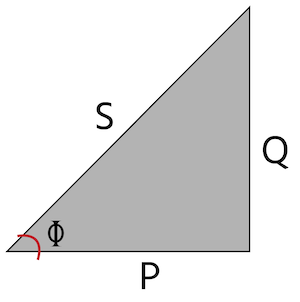
Figure 3: Power triangle showing active power (P), apparent power(S), and reactive power (Q) in a magnetic circuit.
Use Figure 3 to derive the relation between various types of power in a transformer.
- Reactive power
- Active power
- Apparent power
- Power factor
Transformer losses
There are multiple sources of power losses in a transformer.
- Copper loss: Copper losses are caused by circulating currents around the transformer's copper windings.
- Core loss (iron loss): Iron losses are caused by eddy current and hysteresis, which occur in the core due to alternating flux.
- Dielectric loss: Dielectric loss is observed in the transformer insulating material. If the oil deteriorates or the solid insulation gets damaged, it decreases the system's quality, affecting the overall efficiency of the transformer.
How to reduce transformer losses
The various losses in a transformer can cause the device to overheat, leading to damage and a shorter transformer lifespan. It is necessary to reduce these losses to improve transformer efficiency and ensure the optimal performance of the electrical system. Common measures are:
- Use larger copper wire in the transformer windings to reduce copper loss.
- Use high-quality magnetic material, like silicon steel, with the least hysteresis loop area to reduce iron or core loss.
- Stack thin sheets together while making the transformer core; this reduces the eddy current loss.
- Regularly test the oil and maintain the insulation quality to reduce dielectric loss.
FAQs
How to size a transformer?
To size a transformer, determine the load requirements of the electrical system in terms of voltage and current, and then select a transformer with a suitable kVA rating based on the load requirements.
How to calculate transformer VA?
To calculate the VA (Volt-Ampere) rating of a transformer, you need to calculate the product of the voltage and current ratings of the transformer.
What are single-phase transformer sizes in kVA?
The standard kVA sizes for single-phase transformers are: 1, 1.5, 2, 3, 5, 7.5, 10, 15, 25, 37.5, 50, 75, 100, 167, 200, 250, and 333 (KVA)
Is a transformer 100% efficient?
The efficiency of a transformer is less than 100% due to the various types of losses within the device, like core loss, copper loss, and dielectric loss.





